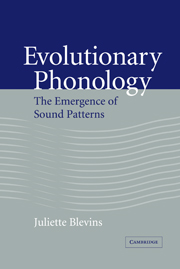9 - Synchronic phonology
Published online by Cambridge University Press: 22 September 2009
Summary
… the universal rules or implicit axioms of grammar aren't really stored or located anywhere, and in an important sense, they are not determined at all. Instead … they have emerged spontaneously and independently in each evolving language …
Deacon (1997: 115)There are many different ways to study synchronic systems. Structuralist approaches examine formal properties of sounds, words, phrases, and discourse and extract recurrent patterns. These patterns form the basis of descriptions that contrast one synchronic system with another, as well as general statements of linguistic principles whose validity does not depend on their cognitive status. Within the generative tradition, synchronic grammars are viewed as reflections of innate linguistic knowledge. Linguistic knowledge is viewed as a type of abstract competence that may or may not be directly reflected in actual linguistic performance. Contemporary grammatical theory confines itself to the description and explanation of competence, and delegates aspects of language performance to other domains of inquiry (e.g. the psychology of human behavior, the physics of speech, language processing). In this chapter, implications of Evolutionary Phonology are assessed for synchronic phonological models. While the approach shifts the bulk of explanation from the synchronic to the diachronic dimension, it also suggests the current relevance of structuralist methods of analysis, and the usefulness of generative divisions between competence and performance.
Phonology and language acquisition
Synchronic phonology is a hybrid system of innate and learned structures. A central question in phonological theory is precisely which aspects of the system are innate and which are learned.
- Type
- Chapter
- Information
- Evolutionary PhonologyThe Emergence of Sound Patterns, pp. 217 - 258Publisher: Cambridge University PressPrint publication year: 2004



